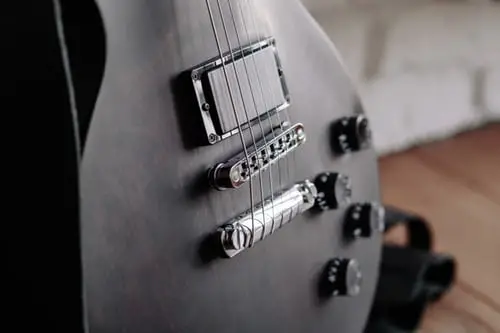Did you know pickups are the biggest contributors to a good tone? This is important to know as a lot of the time, people commonly get creative with trying new strings, amps, and pedals. But, we often fear being creative with guitar pickup construction!
How is a guitar pickup constructed? A guitar pickup is constructed by a magnet surrounded by a coil and together converts vibrational energy (from the guitar strings), into electrical energy that can be amplified into an audio signal. In short, a guitar pickup is a transducer.
In this article, I will discuss the fundamental knowledge of how pickups affect the direct tone of your guitar. The information in this article will form the foundational knowledge for tampering with your guitar pickups to get that desired tone you have been searching for.
So let’s jump right in!
1. What Are Guitar Pickups?
As discussed, a guitar pickup is a transducer with supportive housing to capture the vibrational energy that is created from the guitar strings and then sent into an audio output.
However, to understand more ‘about the pickup’ then you need to understand what a transducer actually is…
A transducer is a device that contains a magnet and insulated copper wire coils. Its sole purpose is to transform one form of energy into another. In the case of a guitar, it transfers vibrational energy into an electrical current.
Once the electrical current is active, the pickup will then send the electrical current to an amplifier where it will be converted into an audio output.
2. Why Are Guitar Pickups Important?
Pickups are important for two main reasons: the first is that it converts vibrational energy into a digital format. The type of pickup is also important as that captures how your guitar will sound once on the digital format.
Creating a Digital Signal
The first reason a guitar pickup is important because it is the most convenient way of transferring the sound that comes from the guitar strings and transforms this into an electrical audio output.
The other way is by using a microphone that work in a similar way.
Once the guitar is outputting an electrical audio signal, it means we can manipulate this sound to our hearts content in audio systems. It can be simple stuff like increasing / decreasing the volume, or more advanced things like experimenting with effects (such as distortion).
Overall, pickups allow us to create an audio signal so we can listen to guitar through speakers / headphones and create mixes in a guitar in a recording studio.
Pickups Affect Tone
We already know that components such as “a bone nut” and “mahogany body” greatly help produce a better tone from your guitar. Nevertheless, the pickups have the biggest influence in our sound.
Without a good set of matched pickups, you will not get an exceptionally good tone. In other words, if you have a guitar that has the perfect setup but has terrible pickups then the guitar will still sound like a cheap guitar.
3. How Pickups Generally Work
The heart of a pickup is a magnet, which is surrounded by a copper coil. A magnet has a North Pole, South Pole and electromagnetic field. When a copper coil is wrapped around a magnet hundreds of times, it will form a recipe that creates an electric signal. The electric signal that is created (from the magnet and the coil), forms electrons inside the copper wire. These electrons stay seated, until a guitar string is plucked. The vibrations from the strings will disturb the electromagnetic field which ultimately pushes the electrons through the wire to the amp.
Energy from the vibrating strings is released over the magnet and copper wire coil. This creates an electric current. The electrical current come in forms of wave’s signals, which ultimately mimic the characteristic sound of the guitar that can then be amplified into an audio signal.
The process from vibrational energy into electrical energy goes through a series of steps listed below:
- Guitar string is plucked
- Electromagnetic field is disturbed
- Voltage current is then created as the coil vibrates
- Current travels through your cables towards the amp
- Amp transfers the electrical signal into an audio output
- Audio output is projected through speakers into sound
As discussed, we control how the electrons move through the wire by plucking the guitar strings. However, more importantly, the frequencies that are captured as the string vibrates determine the tone of your guitar. In other words, the vibrational energy gives the guitar its tonal characteristics.
Some of these factors include the pickup its self (which we will discuss from section 5). But, there are also external factors.
Luckily, we can control all these factors if we know what they are.
4. Pickups & Tonal Foundation
Before, messing with your pickups it is important to understand how the tonal foundation is created. The tone of your guitar is based on numerous factors besides just the pickups. Many external factors such as effect pedals and amps are most obvious for affecting tone. The amp and effect pedals mould the tone after the signal has already been created by the guitar and captured by the pickups.
What does shape the tonal foundation of a guitar are those components that make the guitar function. More so, the tonal foundation are frequencies that are captured by the pickups, before any affects have been applied. Anything that influences the vibrational frequencies will affect the sound of the instrument. This includes both the instrument and the pickup itself, and includes things like:
- Guitar wood – A guitars wood type such as the body, fretboard and neck can be made of all kinds of wood types. Each type of wood has different densities that determine the tone. Maple, ash, and alder are brighter, while mahogany and rosewood are darker.
- Strings – There are endless Guitar Strings you can choose from and they all have different kinds of vibrational properties. Also, the age of strings also determine tone. Pure nickel is darker, while steel/nickel-plated steel are brighter.
- Techniques – the different dynamics you put into your playing also affects the vibrational frequencies. When you play harder and increase the attack, you will hear a high balance of treble in the sound produced.
- Guitar setup – intonation, action, nut type machine nuts etc… all have a small but accumulative effect on the vibration of the guitar/ how the guitar sound is characterised.
- Pickup Position – the pickup position is a direct component of what affects tone massively. This is because between the nut and the bridge the amplitude will vary from low – high. If you place the pickup over the high amplitude area (neck position), you will hear more bass. Whereas, if you place the pickup over the low amplitude area (bridge position), you will hear more treble.
- Pickup setup – For electric guitar/ electro acoustics the pickups is the biggest factor that affects tone. This is because there are many factors that also affect how the pickup captures the sound. Even though things like the [guitar wood, strings, techniques and setup] do contribute towards the vibrations, the pickup captures these vibrations. Different pickups can capture the frequencies in different ways. For example, some pickup may be designed to capture treble more and cut out the mids and bass. Whilst other could be calibrated to capture the high ends more.
- Volume Knob – 250k pots are warmer, 500k pots are brighter
- Neck style – bolted necks are brighter with less sustain, while set-in neck are warmer with more sustain.
Depending on how your pick up is set up can massively affect how the sound is captured. Below I will discuss about the pickups position and the pickup setup and what tone you will expect to hear. By pickups position we discuss the three locations (fret position, bridge position and central). By set up we are discussing the components that go into creating the pickup. This includes the coil design, circuitry, output, magnet, potting and wiring.
5. Pickup Positions
Guitar pickups usually have three main positions: the neck position, bridge position and the central position. The neck position is closest to the fretboard, whilst the bridge position is closest to the bridge and as you would expect the middle position is in-between.
The pickup position is only a small subject of discussion in this article, but I would like to outline that it can have massive effect on tonality. I would even go as far to say that the pickup position is probably the most noticeable change in tone and is a direct response to amplitude (as discussed in section 6). The position has such a massive effect on tone because the amplitude changes as across the whole strumming area. For example, the areas of the string that are being held by the nut or the bridge have lower amplitude. Furthermore, the centre of the string has naturally higher amplitude.
Amplitude of a Strings Vibration
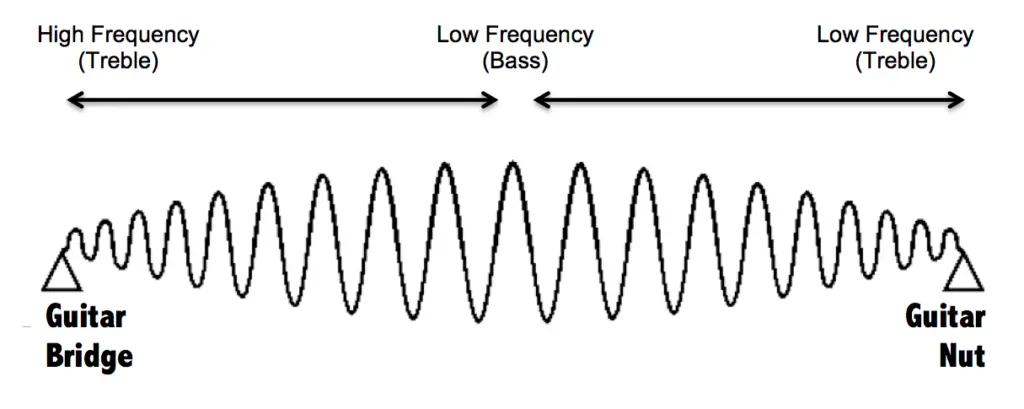
The above image discusses how the amplitude varies across the strings from the nut to the bridge. As you can see the higher, the amplitude increases the bass frequency. Whereby, the lower the amplitude increases the treble frequency.
What Is Amplitude?
The amplitude is how far from the centre, the string vibrates in any direction. At the bridge and the nut are holding the ends of the strings where the amplitude is very small. Whilst at the centre the string that is unsupported the amplitude is far greater. Whereby, we know that the smaller the amplitude the higher the frequency generated by that portion of the strings. We know that the higher the amplitude the more prominent the lower frequencies. This means the pickup will always sound brighter at the bridge position.
To sum up, the bridge will contain higher frequencies, higher frequencies means more treble which is a direct response to a brighter tone.
How Amplitude Affects Tone
If the pickup is positioned nearest to the bridge then it will sound brighter and have less sustain. If the pickup is positioned nearest to the neck it will sounds warmer and more full, with a longest sustain. Whereby, if you position your pickup in the middle position then it is somewhere in-between.
Depending what sound, you want you can be creative. For example, you could have a Humbucker in neck position and a single coil at the bridge position. For my custom guitar, I had the electrics setup so you can go between Humbucker to single coil in each position. Giving me more flexibility in the tone, I am looking for.
6. Coil Design (Single Coil & Humbuckers)
Guitar pickups have two basic coil designs. These two basic coil designs include a Single Coil pick and Humbuckers (double coil) pickup.
A Single coil is the original design for pickups. This is simply a single pickup for each location (being neck, bridge middle) it has one transducer for each string in the pickup positions. Whilst the Humbucker pickup designs have two transducers for each position. Seth Lover was a technical at Gibson and he discovered that by linking two single-coils together at the opposite polarity cancelled out the noise, whilst the valuable signal remained intact.
To that end, each has their unique qualities and so let us discuss these below…
Single Coil
Did you know that the first series of pickups were all single coil pickups. It was only until 1955 when the first humbucker was made by Gibson. However, Fender still stuck with its main design with its Stratocasters and Telecasters.
In terms of Tone single coil are:
- Single-coils are crisper and brighter
- Single-coils sound really nice with clean sounds
- Single-coils definition between strings is clearer
This usually works very well for styles such as blues and open string playing. This is because it distinguishes well between the notes in the chords giving a more precise true sound.
Humbucker
When you think of Gibson Les Paul and pickups, you immediately think humbuckers?
Gibson is mostly associated with humbuckers, and they seem superior in a technical view they are evenly matched when it comes to tone.
In terms of tone:
- Humbuckers are warmer and darker
- Humbuckers work better with distorted sounds
- Humbuckers are less noisy
Humbuckers tend to have a more blurry characteristic between the strings, which is complimented really well with distortion. Creating a really smooth output.
7. Circuitry (active vs. passive)
The circuitry is the method of increasing the voltage output.
There are two types of circuitry when it comes to pickups. The Pickups generate a voltage using 1 of 2 methods: passive circuitry – vibrational movement from the coil and active – vibrational movement from the coil and boosted by a preamp with a 9 volt battery.
Let us discuss these in more detail below…
Active pickups
Active pickups first came on the scene in the 70’s they have advantages that separate them from passive pickups that include:
- Greater tonal clarity
- More tonal consistency at different volumes
- Better reach over long cables
- Stronger amp overdrive
- Cleaner signal
- Wider frequency range
- Sharper attack
- Added sustain
- Extra headroom
Active pickups do not need to use magnets that are as strong or as big coils as the signal is boosted later with a preamp. This reduces “string pull” which negatively affects sustain and tone.
Passive Pickups
As you can see from above there are many noticeable benefits of active pickups. The only advantage of passive pickups is that they have more natural dynamics.
One notable problem with passive pickups is that they use stronger magnets to compensate for without having a preamp. The stronger magnets are needed so that they can generate a sufficient voltage. This can result in causing a condition known as “string pull“, which negatively impacts both tone and sustain and can create a slight humming noise in the background.
8. Output (high vs. moderate)
As discussed in the previous section, passive pickups are generally preferred as you have more control over the dynamics in your playing. This is the noticeable difference from playing soft and playing harder, as well as differences in background noise. If comparing an electric drum kit to a real recording the real drum kit – an electric drum kit has less variation of sound compared to a real drum kit sound. Therefore, for this reason alone passive pickups are the preferred option.
The good news is you can control the output without increasing/decreasing the voltage. You can control the output simply by adding more winds of copper wire. There are three types of pickup outputs for guitar. These include high output, moderate output and vintage output. I will discuss these in more detail below…
- Higher outputs work better for heavy distorted sounds.
- Lower outputs work better for cleaner, more dynamic sounds.
High output
Higher outputs make it easier to drive your amp to distortion, but unfortunately, it gives you less dynamic range. Beyond that, more winding results in a dull, flat sound.
Moderate output
Lower outputs give you a cleaner sound with more dynamic range, but make it harder to achieve that overdriven amp sound.
Vintage output
Vintage-style pickups, which have the lowest output of all, and designed to mimic the weakened magnets found in old classic guitars.
9. Magnets
Magnets are like our planet earth, they have a North Pole, South Pole and surrounded by an invisible electromagnetic field. You can sense this electromagnetic field when you push two sides of the same magnetic field together and feel resistance. Furthermore, magnets are not created equal. Different metal compositions and different level of magnetic strength have a direct impact of the frequencies that is captured and incorporated into the outgoing signal.
Magnet Material
Magnet materials are an alloy, which is a mixture of metals combined. The common blend of material is called AI-NI-CO and it is made from aluminium, nickel, and cobalt, which together form a magnet. The other type of pickup is made of ceramic, which is typically a blend of iron, Ferris and clay. There will be other metallic elements also but these are less significant towards forming a magnet like object.
Most guitar pickups either use alnico or ceramic pickups. Varying the ratio of these alloys results in different strengths of magnetic fields, which offer different tonal characteristics. There are many types of Alnico magnets and each vary in power. Ceramic is the most powerful magnet and unlike alnico it only comes in one form.
- Alnico 2 – which has a similar vintage tone and is complimented by a warmer softer tone.
- Alnico 3 – which has a soft gentle tone and is commonly seen on vintage Stratocasters.
- Alnico 4 – Clear with an even response
- Alnico 5 – which has an even higher output and bolder sound, and is commonly used by guitarists who play in multiple genres. Beef up the mid-range frequencies for more balanced tone
- Alnico 8 – which has the most aggressive heavy sound of all, and the strongest magnetic pull. This has a beefed up treble.
- Ceramic – Ceramic magnets are made from ferrites (often iron oxides). Magnetically speaking, ceramic magnets produce a stronger field than Alnico. The result is a slightly hotter sounding pickup with more treble response. Overall, this creates crunchy sounding tone as it boosts treble frequencies even more than alnico 8.
The tone as it induces more treble. With this contrast in treble you will usual find it is a choice between brightness and warmth, dynamical or smooth and resonance and sustain.
The general rule of thumb is that greater the magnet strength will increase the treble frequency. This means with more powerful magnet strength will increase brightness, smoothen out the tone and increase sustain. If the magnet has less power then this means lower treble and higher mids. This will increase the warmth sound, harsher dynamics and increase tonal resonance.
Obviously all these factors are important and so you want to get the right balance of everything that is also complimentary to the guitars components and guitar setup.
Alnico
Alnico magnets have different compositions, which makes them vary in presence and power. It is important to note than no composition is better than the other, and each one provides valuable tonal qualities. Generally, the less powerful magnet means more dynamical response, whilst more powerful means it is smoother and more even sound.
Alnico magnets has a great advantage because of this because you have more options of power available. This means you have many options to experiment with, and you can choose which magnets compliment the guitar in question. These blend of Alnico metals are really popular as they have the ability to maintain its magnetic properties overtime.
Many people automatically say that alnico is superior to ceramic pickups for this reason. However, alnico can erode faster if exposed to alkaline. In addition, if you try to boost an alnico signal to much then you will sacrifice tone.
Ceramic
Ceramic is also a common material used for guitar designed for adding heavy distortion such as genre like metal and rock. This is because these magnets are high-output which in turn retains high end and an overall even sound, which is preferred when adding heavy distortion.
Ceramic is a naturally more powerful magnet and by contrast for an alnico to match the power of the ceramic magnet more coils will be required to boost the output, which in turn will ruin the tone. However, some styles do not require a high out output such as jazz.
10. Magnet Layout
There are different ways magnets are layout in the pickup. When dealing with the layout of the magnet it is also known to greatly influence tone. There are three popular magnet layouts, which include individual magnet poles, steel poles that extend from a magnet bar or blades. Let us look at the three popular layouts:
Disk Magnets
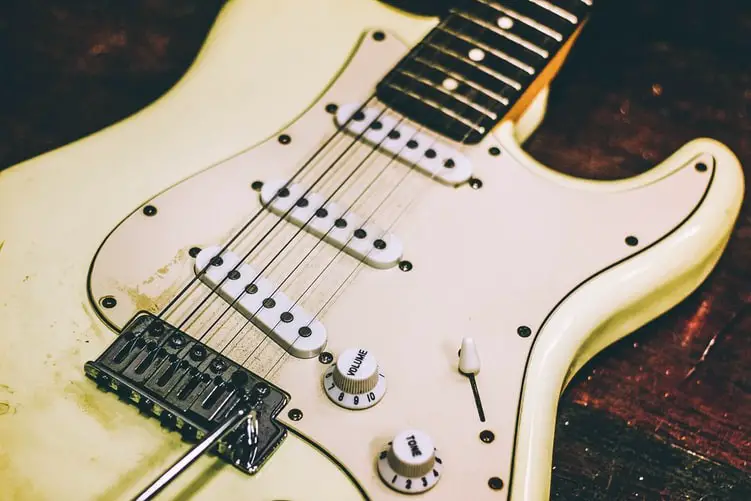
These are individual magnets places on each transducer for every individual string. You get a magnet per string in the single coil design or two magnets per string for the humbucker design. This formation of the pickup will produce a thinner, brighter sound. These are commonly used on Fender guitars and other single coil pickups.
Bar Magnets
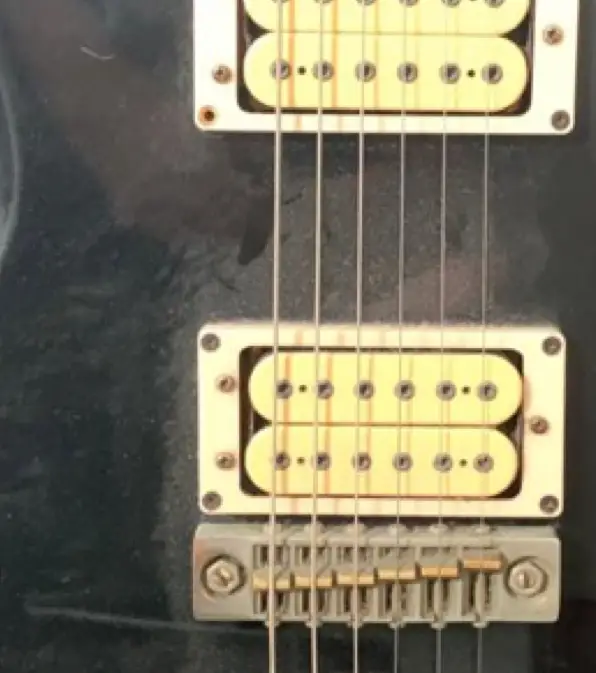
Bar magnets are steel poles extending from a magnetic bar, which is positioned behind the pickup. A small steel pole attaches to the magnet and becomes magnetised by induction. This means the steel creates a magnetic field from the magnetic bar. The steel poles are then positioned in front of the strings. Whereby, you can have more flexibility where you can position the magnetic field against the strings. Which have a fatter, dark sound, and are commonly used on Gibson guitars and other humbucker pickups.
Blade Magnets
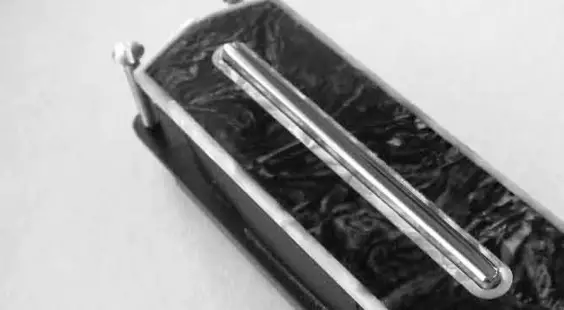
Blade magnets have a triangular shape edge and extend across all the strings. This will create a different magnetic field, which replaces the individual pole pieces with a single metal bar, and is known to have a thicker more sound with string bends.
11. Potting
Potting is used to hold the pickup components in place and prevent any movement or vibration between parts. This is done by dipping pickup in wax. The potting process is important because it prevents feedback from your instrument. Feedback can get in the way of your tone making it sound muddy which makes it less pleasant to listen to.
- Potted – potted pickups removes feedback from your guitar
- Unpotted – unpotted pickups will catch random sounds in the air
Even though feedback sounds bad in theory there is a unique quality that some players really like. Nowadays modern guitar pickups are potted by default and so it will be hard to get the vintage effect with newer guitars.
12. Wiring (Parallel Vs. Series)
The wiring techniques are only applicable to humbucker pickups and the coils being connected in parallel or as a series. In almost all cases, parallel wiring is the standard method used with modern day pickups, and series wiring is considered as more of a custom modification.
Parallel Wiring
Parallel wiring includes the signal being split in two from the beginning and re-combined at the end.
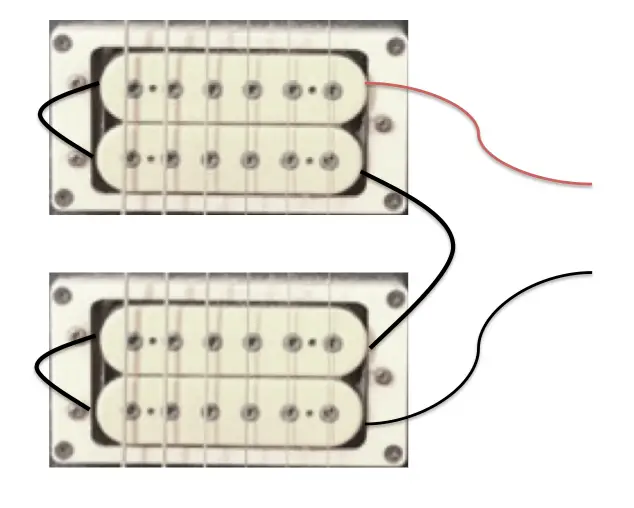
This technique results in a brighter sound, with a comparatively lower output.
Series wiring
Series wiring the signal travels along a single path through both coils.

This results in a warmer sound, and higher output.
13. Size of the Pickup Cavity
Your guitar pickup will fit into two sized cavities. This is depending on whether your guitar uses single-coils or humbuckers. The body of the guitar will be cut to fit that specific-sized pickup inside the cavity.
If you are switching from humbucker to single coil the change is simple. But, if you are switch from single coil to humbucker then the change can be problematic as a humbucker does not fit inside a single coil slot.
Luckily, a solution does not warrant cutting new holes in your guitar. These days, there are plenty of single-coils shaped like humbuckers, and vice versa.
Changing from Humbuckers for Single-Coil Cavities
If you want to fit a humbucker pickup into single-coil pickup slot then you have 3 options:
- Reverse Wound Single-coil – reverse wound single coils wind the middle pickup in the opposite direction. This is so it cancels noise when combined with either the bridge or neck pickup.
- Rail Humbuckers – rail humbuckers are dual-coils that sit “side-by-side” like normal humbuckers, but will fit into a single-coil cavity slot because they are half the size. The good news is that these are intended to perform like true humbuckers, both in sound and noise cancellation.
- Stacks – stack pickups are actually a dual-coil stacked from “top-to-bottom”, rather than “side-by-side” like the normal humbuckers. They sound similar to, though not exactly like single-coils, and have the noise cancellation as well.
On occasion, you can even find pickups that combine rail and stack designs to essentially cram 4 single-coils into one extremely high output humbucker cavity.
Changing from Single-Coils for Humbucker Cavities
If you want to get a single-coil tone with a humbucker slot then you have three options:
- Single-coil in a Humbucker Sized Casing – a single-coil in a humbucker sized casing sounds just as a standard single coil does.
- Coil-Split Humbuckers – coil split humbuckers are also known as 4 wire humbuckers which, when engaged, performs like a lower output vintage single-coil. It does this by shutting off one of the two coils and as you would expect does not cancel noise.
- Coil-Tapped Humbuckers – Coil-tapped humbuckers only use a fraction of the winding in both coils when engaged. This will get a sound similar to a single coil, but will cancel the noise/ hum-cancelling.
Conclusion
Overall, the pickups capture that initial “tonal foundation”. There are hundreds of factors that can affect the how the wave signals are produced (such as wood types, strings etc…), however, one of the biggest factors is the type of pickup you have installed.
The pickups capture the sound so it can be transferred to a digital or analogue output. While the tone of that sound is determined by many factors It is you pick up that takes those frequencies as passes them into audio.
Many factors affect how to sound is transmitted and picked up such as the types of coils that are being used, the output, circuitry, plotting and magnets… We discussed that vibration is characterised by the prominent frequencies that are present in the vibrating string. For this reason, the relationship between the components (such as the magnet and the coil) has to be complimentary.
As discussed each component has its unique characteristics and with a carful set up you can achieve different sounds. For example, you can still get dark heavy sounds from humbuckers, and clean twangy sounds from single coil.
If you liked this article and you feel it helped you then please leave a comment and share it with someone who might find it useful. I am actively updating these articles daily and so I will see any comments made within a few days of posting! You can also visit Parts Of A Guitar? If you want to find more relevant posts to read.
Thank you so much and have a great day!

